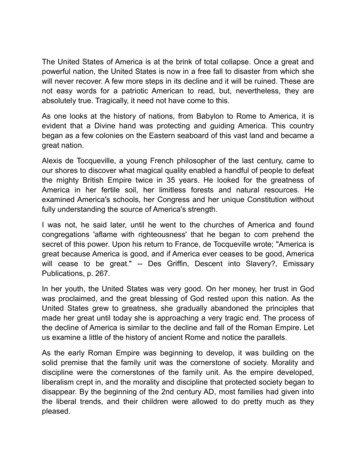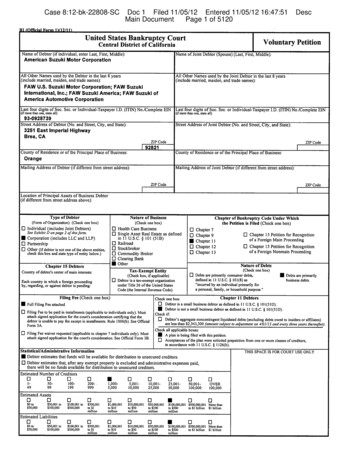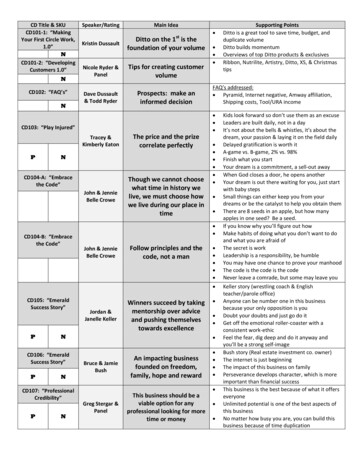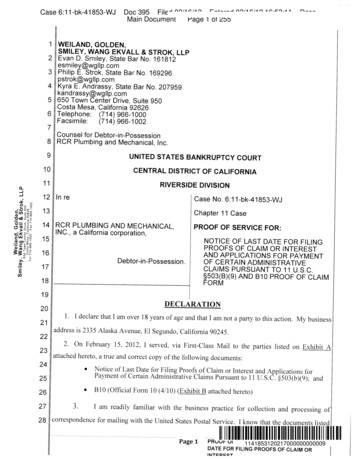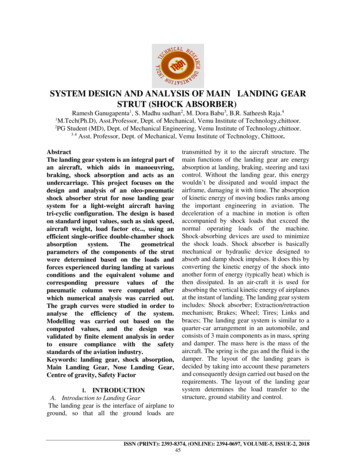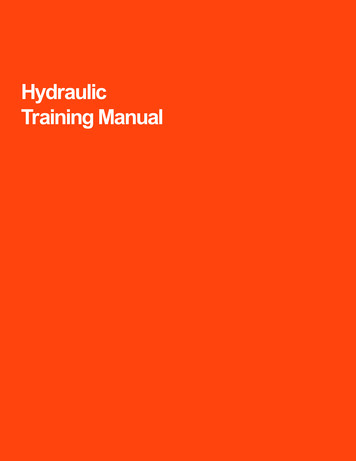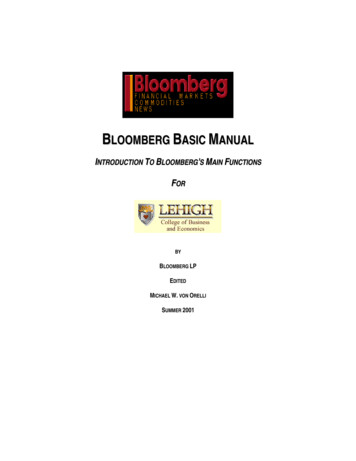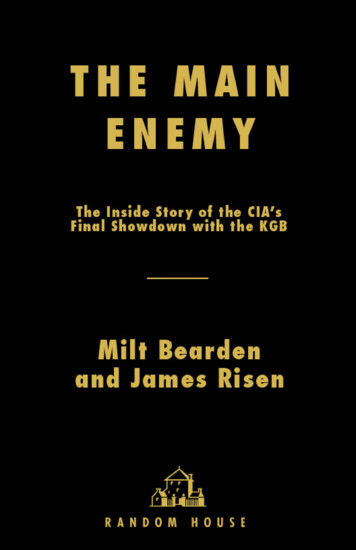
Transcription
THE MAINENEMYThis book has been optimized for viewing at a monitorsetting of 1024 768 pixels.
eR A N D O MN E WH O U S EY O R K
THE MAINENEMYTHE INSIDE STORY OFTHE CIA’S FINAL SHOWDOWNWITH THE KGBMILT BEARDENANDJAMES RISEN
Copyright 2003 by Milton Bearden and James RisenAll rights reserved under International and Pan-AmericanCopyright Conventions. Published in the United States by RandomHouse, an imprint of The Random House Ballantine Publishing Group,a division of Random House, Inc., New York, and simultaneously inCanada by Random House of Canada Limited, Toronto.Random House and colophon are registered trademarksof Random House, Inc.Library of Congress Cataloging-in-Publication Data is available.e-ISBN 1-58836-306-6Random House website address: www.atrandom.comv1.0
To Marie-CatherineTo Penny
FOREWORDThe Main Enemy is the first comprehensive history of the climactic secret battles between the CIA and the KGB in the closing days of theCold War, when the Berlin Wall fell and the Soviet Union imploded.Beginning with the watershed “Year of the Spy” in 1985 and followingthrough to the collapse of the Soviet Union, the book chronicles themajor espionage engagements between the CIA and KGB through theeyes of the spies who fought them.This is the story of the lives and careers of the generation trained asspies in the shadow of the Cuban missile crisis, who took charge at theCIA and KGB just as Ronald Reagan and Mikhail Gorbachev rose topower in the 1980s and then suddenly found themselves at the centerof a maelstrom of historic change. Many of the CIA and KGB officerswho faced off in the Cold War have returned to civilian life. And liketheir fathers, the combat veterans of Normandy and Stalingrad, theyhave much to remember.The Main Enemy is the product of a unique experiment, an effort bya CIA insider and an outside journalist to combine forces to write amore revealing and human narrative than either could on his own.This truly was a collaborative project, but the authors also adhered to astrict division of labor in order to abide by certain rules imposed by theCIA on its former officers. As required under CIA regulations, MiltBearden submitted his portion of the manuscript to the CIA for prepublication review, and then he made redactions requested by theagency. Those redactions were modest and did not affect the storybeing told.
viiiFOREWORDJames Risen did not submit his portion of the book to the CIA forprepublication review. In order to provide a consistent narrative tone,Milt Bearden is referred to in the first person throughout the book,even in those sections of the book written by James Risen.The book is based on hundreds of interviews conducted over thecourse of three years with dozens of CIA and KGB officers on eitherside of the divide. Where there is dialogue in the book, it correspondsto the specific recollections of one or more of the people present in theroom. Beyond this, we have taken the liberty of reconstructing severalCIA cables. With the exception of an excerpt from one, these are notactual cables but are reconstructions by Milt Bearden based on histhirty years of reading and writing CIA cables; they are similar in toneand language to the real cables sent in each instance.
ACKNOWLEDGMENTSTo all of the men and women who fought the battles described inthese pages, we are in your debt. Many of you could not be named because the job is not yet done; others wished not to be named, and wehave honored that wish. But your anonymity does not diminish yourcontribution.We also owe an enormous debt to our editor at Random House, thematchless Joy de Menil. The Main Enemy is infused with her energy andvision.And one of our greatest advocates has been Tina Bennett, our literary agent at Janklow & Nesbit, whose enthusiasm for our project neverwavered.We wish to thank Jill Abramson, the Washington bureau chief ofThe New York Times, who has been a steadfast friend throughout theyears of work on The Main Enemy.We are also grateful for the research assistance of Barclay Walsh, research supervisor in the Washington bureau of The New York Times.
CONTENTSForeword / viiAcknowledgments / ixPA R T O N EThe Year of the Spy / 1PA R T T W OThe Cold War Turns Hot in Afghanistan / 205PA R T T H R E EEndgame / 369Epilogue / 525A Note on Sources / 537Select Bibliography / 539Index / 543
P A R TO N ETHE YEAR OFTHE SPY
1Washington, D.C., 1830 Hours, June 13, 1985There was nothing more he could do, Burton Gerber told himselfagain. The run had been choreographed like a ballet, of this he was certain. He had imposed his own iron discipline on the night’s operationand had personally signed off on every detail, every gesture. Now thatthe route had been selected, he could close his eyes and visualize eachintersection.Gerber knew Moscow as well as any American, and from the Central Intelligence Agency’s headquarters half a world away, he routinelyinsisted on approving each turn to be followed on the operational runfrom Moscow’s city center through the bleak outer neighborhoods.Night after night during his own years in Moscow, he had taken hiswife, Rosalie, to obscure Russian theaters in distant parts of town rarelyfrequented by foreigners. His knowledge of Russian and his reputationas a movie buff had served him well. A good case officer has to learn hiscity, he told himself.From his office in Langley, Virginia, Gerber had approved the scriptfor the conversation that was to take place at the end of tonight’s run,during the ten-minute meeting in the shadows of the Stalinist apartment blocks on Kastanayevskaya Street that was the sole object of theoperation. Finally, Gerber had demanded that rigorous rehearsals beconducted inside the cramped working spaces on the fifth floor of theU.S. embassy in Moscow before the run was launched.A wraith-thin Midwesterner, Jesuitical in his approach to his work,Gerber was one of the most demanding spymasters the CIA had eversent against its main enemy, the Soviet Union’s KGB. As chief of the
4THE MAIN ENEMYCIA’s Soviet/East European Division for the past year, he had made hismark. His exacting attention to the details of espionage tradecraft andhis impatience with those who failed to meet his standards were legendary. Some critics called him a screamer who berated subordinates,but most respected his single-minded devotion to his job and, in anold-fashioned sense, to duty. Gerber was a complex man who evoked ajumble of emotions from those who worked for him. Longtime Soviet/East European hands studied him with the same intensity they broughtto their analysis of the Soviet leaders in the Kremlin. What were they tomake of a man whose greatest avocation was for the care, feeding, andpreservation of wild wolves?The truth was that Burton Gerber was a deeply spiritual man, aRoman Catholic who felt a moral obligation to the Russian agents heand his case officers were running. He lit a candle at Mass for each oneof his agents unmasked and arrested by the KGB. He had come homefrom serving as station chief in Moscow three years earlier, so he understood the dangers of operating inside the Soviet bloc better thanmost at CIA headquarters. He believed that nothing less than perfection was owed to America’s Russian agents, and if he yelled at case officers who failed to meet his standards, so be it. Cable traffic betweenLangley and Moscow was frequently dominated by a tense running debate between Gerber and his Moscow station chief, Murat Natirboff,over the minutiae of operations. There were some in SE Division whowhispered that Natirboff was miscast as Moscow station chief, and itwas increasingly clear that Gerber didn’t trust him to get things doneright. He seemed to believe he had to run Moscow operations himself—so much so that to some within SE Division, it sometimes felt asif Burton Gerber had never left Moscow.But at some level, beneath the rigorous precision so necessary to asuccessful spy, Gerber also believed in both faith and fate. And so, afterhe signed off on the night’s run, he closed the door to his fifth-floor office at CIA headquarters and smoothly turned his mind to other duties.It was almost perfect late spring weather in Washington. The daywas ending quietly as Gerber left for his home in a graceful old apartment building in Washington’s Kalorama neighborhood. He hadplanned a modest dinner that night, after which he had promised tojoin a night training exercise.
THE YEAR OF THE SPY5At the very moment one of his officers would be winding his waythrough Moscow to meet the CIA’s most valuable Soviet spy, Gerberwould be watching green trainees playacting espionage on the streets ofWashington. Better, he thought, that he devote his time to making certain that the next crop of officers be properly schooled than waste hisenergy fretting over details of a run he could no longer control. Gerberwilled himself to stop worrying, to move on.This was no routine training course, to be sure. Like the Navy’sfamed Top Gun school for fighter pilots, the CIA’s “Internal Operations” course was the most arduous training program the agency had tooffer. It was restricted to a handpicked elite—case officers slated for assignments in Moscow, Warsaw, Prague, and other capital cities in theSoviet empire. These were among the most difficult jobs in the CIA.The physical and mental stresses that came with the constant surveillance, the threat of exposure and arrest, meant that “inside work” was ayoung case officer’s game.After searching for some time for new tactics to defeat the KGB’ssuffocating surveillance in Moscow, the agency hit upon the idea ofadding some green officers to the Moscow pipeline, recruits whowouldn’t be easily recognized from other tours of duty. The decision tosend rookies to Moscow placed an added burden on the IO course. Ithad to provide the most realistic training possible for officers who hadnever before faced a hostile opposition, much less the professional spycatchers of the KGB’s Second and Seventh Chief Directorates.Run by Jack Platt, a gruff ex-Marine and longtime Soviet targets officer, the six-week course simulated “Moscow Rules.” The new caseofficers had to pass messages and receive documents from “spies” evenas they were being trailed through Washington by teams of FBI agentsplaying the part of a hostile counterintelligence service. The FBI agentsplayed hard—because the course kept them sharp for following realSoviet spies. Still, the best-trained CIA officers in the course could defeat the FBI, often through the use of sophisticated electronic devices,such as burst transmission equipment, that allowed them to pass messages without face-to-face contact.But the FBI always had a lesson in store. The trainees—often withtheir spouses in tow—would go out on what they thought was an ordinary operation and walk into an explosive surprise arrest. They’d be
6THE MAIN ENEMYroughed up and charged with drug dealing by FBI agents who were totally convincing in making it seem as though the bust had nothing todo with the IO course. After a few hours of questioning, only the mostcontrolled students had the will to hold back their CIA connections.Invariably, some would try to talk their way out by explaining that therehad been some horrible mistake: You see, Officer, I was loitering on a deserted street corner late at night with this woman, who happens to be my wife, aspart of a CIA training exercise, not to sell drugs.Gerber had invited Jim Olson, who had served with him inMoscow, to join him for dinner before they both went and played theirparts in the training exercise. Olson, chief of internal operations for theSoviet Division, had amassed a remarkable record in Moscow and wasnow one of Gerber’s most trusted lieutenants. But when he arrived atGerber’s apartment, Olson brought devastating news: Paul Stombaughhad been arrested in Moscow.Olson’s words hit Gerber like a gut shot. He knew instinctivelywhat Stombaugh’s arrest meant: The CIA’s most important spy intwenty-five years had been rolled up by the KGB. It meant that AdolfTolkachev, the billion-dollar agent, code-named GTVANQUISH, theman Stombaugh was supposed to meet, had been fatally compromised.Typically, when an operation was carried off successfully in theheart of Moscow, right in the middle of a rolling sea of KGB surveillance, Langley wouldn’t hear about it until the next morning. To keepthe KGB from guessing that an important operation was under way,case officers returning from a late-night run would simply “get black,”disappear into the city, and wait until the next morning to reinsertthemselves into their cover jobs at the embassy. So only when the officer reported to work the next day would he go through a thorough debriefing, while the tape recordings of his brief encounter with the agentwere transcribed.That was when a flurry of messages would come pulsing into Langley, providing the details of how the run had unfolded the night before.Adrenaline would be pumping across the cable traffic, and well into thenext day it would infect the small circle in the SE Division managingthe case. Days later, the tape recordings of the agent meeting would arrive by diplomatic pouch, allowing senior SE Division managers tohear the tense voices and feel the strained emotions of the Moscow
THE YEAR OF THE SPY7street encounter for themselves. They could then try to gauge the stateof mind of an agent most of them had never met, as well as the performance of a case officer trying to ask all the right questions while constantly scanning his surroundings for signs of the KGB.Success took a while to percolate through the system. But word offailure came quickly. It would originate in Moscow in the middle of thenight, a clipped cable chasing the sun and arriving in Washington in theearly evening. The first sign of trouble might come from the wife of aMoscow officer, signaling that her husband had failed to return
The Main Enemy is the product of a unique experiment, an effort by a CIA insider and an outside journalist to combine forces to write a more revealing and human narrative than either could on his own. This truly was a collaborative project, but the authors also adhered to a strict division of labor in order to abide by certain rules imposed by the CIA on its former officers. As required under .

